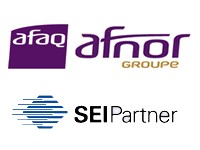Organizations wanting to improve their processes find it difficult to select the best approach for process improvement. Most effective approach should be the integrated approach taken to improve the process of the organization and it should not be focused on a particular approach or methodology. Capability Maturity Model Integration (CMMI) and Six Sigma are two popular, effective and result oriented approaches that can be used with each other. Before moving with the implementation of CMMI and Agile, we need to have understanding of the relationship between them. Here we will try to define the relationship that exists between CMMI process areas and Six Sigma. These two can be combined with each other to form a strategy that will enable the organizations to lead and have better control in terms of quantitative project management and organizational business goals. Now let us have a look at what each of these terms i.e. CMMI and Six – Sigma means.
What is CMMI?
Capability Maturity Model Integration is a framework for process improvement and is developed by Software Engineering Institute for Software Development, Services Providers and Organization involved with Acquisitions.
CMMI
- is a process improvement approach that provides organizations with the essential elements of effective processes
- can be used to guide improvement across a team, project, division, or entire organization, and helps to set process improvement goals and
- priorities, provide guidance for quality processes, and provide a point of reference for appraising current processes.
What is Six – Sigma?
Six Sigma is also a process improvement methodology and requires the implementation of a measurement – based strategy. The focus of Six – Sigma remains on process improvement, through the application of Six Sigma improvement projects. There are popular implementation approaches for Six Sigma projects is DMAIC. DMAIC is abbreviation of Define, Measure, Analyze, Improve and Control. Six Sigma processes are executed by trained professionals known as Six Sigma Green Belts and Six Sigma Black Belts, and are overseen by Six Sigma Master Black Belts. Six Sigma was meant for the manufacturing industry and their improvement. With the time it has matured enough to be deployed in software industry. Now Six Sigma is applied by Software Organizations to apply measurement related process improvement. Six Sigma is used to reduce number of defects, reduce cycle time, increased productivity and thus increasing customer satisfaction and business profitability. Following are the key assumptions made in Six Sigma implementations:
- Every activity we do is a process.
- All processes have a component of variability.
- Data can be used to understand variation in these processes and thus to improve them processes.
CMMI and Six Sigma integration
A number of organizations worldwide have implemented CMMI and Six – Sigma together and have provided this information about successful implementation in public domain. They were brave enough to break the traditional thought about separating CMMI and Six Sigma. Following steps can be taken for effective implementation of CMMI and Six – Sigma.
CMMI process areas implementation as Six Sigma projects
This means that the Six Sigma implementers should implement CMMI process areas as Six Sigma projects. This can include individual process area or a number of process areas clubbed together in a group. These implementers would use the existing data and would define the problem and opportunities using the available data to form the improvement using cmmi processes. These improvements will be in the direction of the organizational business objectives. This may involve using existing processes or devising new processes for e.g. DMAIC or Lean.
Achieving CMMI high capability and high maturity using Six Sigma
Six Sigma has the synergy to work for CMMI High Maturity Process Areas i.e. Quantitative Project Management (QPM), Organizational Performance Management (OPM), Causal Analysis and Resolution (CAR) and Organizational Process Performance (OPP). Six Sigma can be applied directly to these CMMI high maturity and capability process areas. For example DMAIC can be used to Define, Measure, Analyze, Improve and Control the QPM and them QPM issues can be analysed and Controlled by CAR. This way we can use the power of Six Sigma and its methodologies like DMAIC to Plan, Execute, Analyse Control and Improve the CMMI High Maturity and Capability process areas.
Six Sigma for improvement and optimization of Organizational goals and processes
Organizational decision making for improvement activities and management initiatives can be supported heavily by Six Sigma. There are many ways Six Sigma can be applied for the same:
- Optimization of the CMMI Process areas
- Accelerated Organizational process improvement
- Cost reduction for SCAMPI Appraisals
- Identification of highest priority organizational problems to inform decisions about improvement project selection and portfolio management
DMAIC is one Six Sigma methodology that can be used to define, measure, analyze, improve and control various processes implementations. CMMI can be used in collaboration with DMAIC for process improvement. Once all CMMI processes are in place, DMAIC can be used for Quantitative Management that includes defining, measuring, analysing and then improving and controlling as required.
How DQS India can help your organization in achieving CMMI Maturity Levels using Six Sigma?
We at DQS India have professionals with years of experience in working with Software industry and different domains. We have professionals who are Master Black Belts, Black Belts and Green Belts and have many years of experience. DQS India can provide the platform for blending CMMI with Six Sigma to achieve CMMI maturity Levels 3 to 5.
We can help you in the development of Customised program for CMMI Implementation with Six Sigma Practices.


